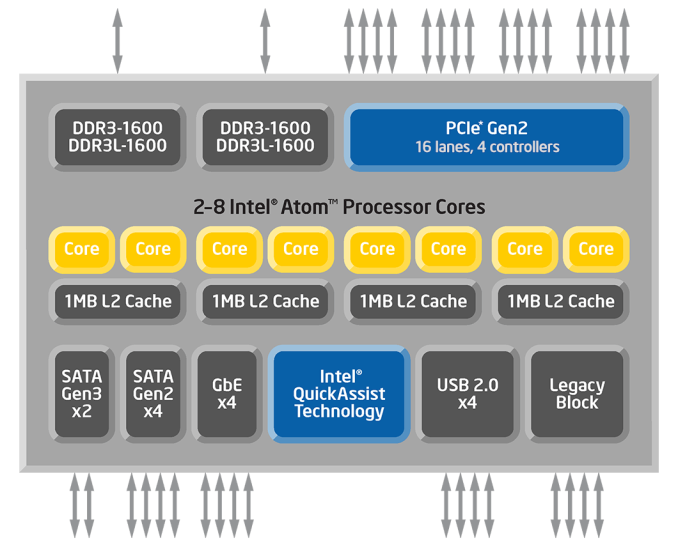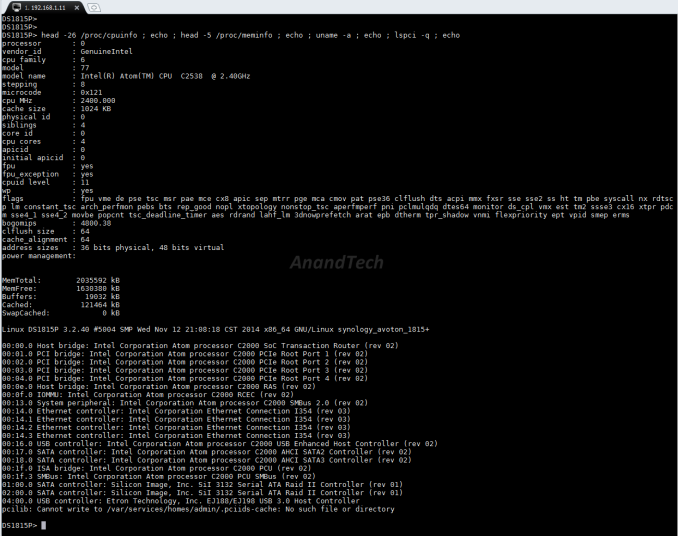Synology DS1815+ 8-bay Intel Rangeley SMB NAS Review
by Ganesh T S on November 18, 2014 6:30 AM ESTPlatform Analysis
The higher end segment of the SOHO / SMB NAS market uses Intel's Core-series and Xeon CPUs to deliver the required performance while supporting a large number of drive bays (typically more than 8, in a rackmount form-factor). Over the last four years or so, Intel's play in the other tiers has been mainly with its Atom CPU lineup. Back in 2010, Intel pushed the 45 nm Atom D410 / D510 / D525 for NAS units. In 2012, it was the 32 nm Atoms, the D2550 and D2700. All of these were based on the in-order Bonnell microarchitecture which was fast becoming dated compared to the advancements being made by the ARM SoC vendors. In moving from 32nm to 22nm, Intel completely revamped the microarchitecture for their Atom cores. Bonnell was replaced by Silvermont, bringing out of order execution and other improvements into the picture. Silvermont's applicability to a variety of power profiles meant that there were multiple product lines that ended up using the CPU cores. Bay Trail is proving very effective in tablets and also makes up QNAP's TS-x51 and TS-x53 Pro NAS series. Merrifield and Moorefield are trying to break into smartphones, but it is Avoton and Rangeley that are more relevant to the storage appliances market.
The different product lines integrate different I/O around the Silvermont cores depending on the target market. Avoton is meant for microservers and cloud storage platforms, while Rangeley is meant for communication and network infrastructure. Both of them integrate similar I/O around the cores, but the Rangeley parts have an updated crypto engine. The block diagram of a generic Rangeley part is provided below.
There is a wealth of I/O (2x SATA Gen 3, 4x SATA Gen 2 and up to 16 PCIe 2.0 lanes) for the storage subsystem, and the parts also support up to 4x 2.5 Gbps network links. From the viewpoint of the Synology DS1815+, the above block diagram should be considered in the context of the information gleaned via SSH access to the unit.
The DS1815+ uses the Intel Atom C2538 SoC which has four Silvermont cores running at 2.4 GHz. It is backed up by 2 GB of DRAM. The Atom C2538 has 16 PCIe 2.0 lanes. The Silicon Image SiI3132 PCIe to 2-port SATA II host controller uses a single PCIe 2.0 lane on the host side. There are two of them using up two PCIe 2.0 lanes in total. Unlike the DS415+ in which the USB 3.0 ports were provided by the Etron EJ168 USB 3.0 host controller, the DS1815+ uses the Etron EJ198. This USB 3.0 host controller uses two PCIe lanes to enable the four USB 3.0 ports found on the rear side of the unit. The four Ethernet controllers are all based on the Intel I354. Despite being 2.5G-capable, the transceivers they are connected to make them GbE ports.
The more interesting hardware aspect is the absence of any PCIe to SATA bridges for the internal ports. Given that the C2538 has only a total of six SATA ports (2x SATA III and 4x SATA II) and there are no bridges in the SSH report, it can be inferred that a port multipler (1x SATA host to 2x SATA device) such as the ASMedia ASM1092 must be in use. However, without opening up the unit (which we haven't done yet, given our limited time to bring out the review), this can't be confirmed.
On the software front, the DS1815+ runs Linux (kernel version 3.2.40). We have covered DSM 5.0's setup and usage impressions in our recent DS214play and DS414j reviews. There is not much point in rehashing the same excellent setup and usage experience. That said, with the ioSafe 1513+, we also started looking at iSCSI support in NAS units. We will be looking at that aspect in this review also.












65 Comments
View All Comments
LoneWolf15 - Tuesday, November 18, 2014 - link
The thing is, no business is going to base a NAS on hardware that's "going to goodwill anyhow" unless they're run on a shoestring budget or one that doesn't comprehend data integrity. $750 is worth the time because it gives you the following with Synology:-Easy setup
-Easy replication to a second Synology
-Easy migration from a failing NAS
-Easy reporting/monitoring for small to medium business
-Easy administration for a business that doesn't have your level of IT knowledge
This product isn't for you, but actually, the Synology DSM operating system *is* a proven OS; it's at version 5.1 now. The argument for purchasing one is the same as the argument for buying a server over building your own --in business, there's good reason for letting someone else do that part of the work for you, so you can concentrate on, you know, --business.
carage - Wednesday, November 19, 2014 - link
It will work great until it get hits with SynoLocker again.SirGCal - Wednesday, November 19, 2014 - link
I don't know any business that would use these as secure NAS storage anyhow. Businesses have an entirely different type of storage, far faster, more secure, and actually quite larger. The last bank we bought is a simple rack configured for 24 drives in volumes of 12 that you can use any way you choose. These are for consumers, not businesses.SirGCal - Wednesday, November 19, 2014 - link
And for the record, I don't work with hardware, I write software by trade. Although my direct trade has nothing to do with helping me learn to set these up. That knowledge came from a few minutes on Google and I can follow instructions. I've also fixed a failed array, moved them to new hardware, etc. ZFS is actually one of the oldest and most secure RAID type format, originally created for Solaris/Sun systems very long ago. The nice thing about modern ZSF arrays is how easy they are to recover, unlike hardware-raid options which even putting the drives in an identical controller might not work.And all of your bullets are easily covered by the combination accept the last which, honestly, if your level of IT is that low in any company, you should be out-sourcing all of your storage and IT needs and not even trying to do this alone. But it would be almost questionable why any company that small would need live, fast storage like this. New cloud services are generally far more their cup-of-tea for the very small businesses. Literally buy it and forget it, use it like a drive within your company, fully encrypted, etc. and surprisingly quick considering. Even my extremely large company has a few online storage systems for the 'very cheap' departments to use instead of spending a bit more for a rack in the data center and tape backups there-after. The cloud is far cheaper if you're not talking hundreds of Tera-bytes and extreme speed access. That's from the business side of the discussion. But again, these are aimed at consumers.
DiHydro - Wednesday, November 19, 2014 - link
"Businesses have an entirely different type of storage, far faster, more secure, and actually quite larger." You mean this same hardware in a rack mount? Did you even read this article? Any business employing 1-50 or so people would be the target for this NAS. Something like a hairdresser, contractor, accounting firm (hopefully with offsite backup also). You are too entrenched in your view point to see that others have different priorities and objectives. Yes, for people like you and I, setting up an 8 bay NAS with generic components is trivial, but the manager at your grocery store doesn't know, and doesn't care. They will buy something that is plug-and-play, has a warranty, and has the storage they need. Imagine if that manager hired you to set up a storage solution, would you custom build the hardware and install Ubuntu for it? No, you would quote out one of these, and a couple hours of install. Making you a nice profit, and not having the buyer have deal with you and the cobbled together solution for any little problem in hardware compatibility, or down time, or interoperability issues.SirGCal - Friday, November 21, 2014 - link
The manager at the grocery store isn't responsible for buying hardware and would have no need for said hardware. Nore would a hairdresser... And even if they did need storage, online storage would be more cost beneficial in most of those cases. But what are they going to store? The grocery store has a giant IT system tied into the parent company with their proprietary software. The Hairdresser has contact information, assuming they have their own store and not working for a chain... My parents both work at a grocery while they retire. And unfortunately, mom & pop groceries are all but gone due to the push of the horrible corporate arm. And I help my wife's hairdresser who does my hair for Locks for Love when I grew it out (a free everything when I donated). The most she ever needs is her laptop cleaned of malware. All of her contact information is safely and securely stored in the 'cloud' (god I hate that word... it's on servers on the internet... but let's tag it with a stupid word now that speeds are high enough we can push to outside storage easier...) Nice try though. Ironic on both counts, but no dice.verraneventide - Tuesday, October 27, 2015 - link
SirGCal: yes, I am resurrecting this comment chain almost a year later. I rarely post on the 'net to comments like these: so lucky you. We just deployed this NAS for my client. My client is a small retail business (20+ employees) who sell medical scrubs and equipment. They own three retail stores, run two large e-commerce sites and handle a lot of phone orders. We setup the NAS to retain local disk images of all their machines. We also use it for VM hosting and additional file sharing needs. They use me as a part time contractor because they have a very tight budget and cannot afford a full time (competent) IT resource. They would much rather purchase a device, with manufacturer support, like this, than have me spend labor hours building something out that I may not be around to support later (i.e. if I get hit by a bus). We also backup everything to the cloud as a redundant fail-safe. This *includes* everything on the NAS. Sure, I could have set up my own solution. But, as a previous commenter mentioned: finding and purchasing the necessary hardware, setting it up, testing it and deploying it would have been more time consuming, and therefore more expensive. I am calling bull**** on going through that entire process in only 30 minutes. And, again, a custom solution would have been without manufacturer support. So, "no dice".awktane - Tuesday, November 18, 2014 - link
Configure a NAS unit like this beside someone who is trying to create a HA iscsi server with plex, picture sharing website, and cloud synch replacing onedrive/dropbox/etc with little prior knowledge. Then do watch them both when something goes wrong. Time is money.Gigaplex - Tuesday, November 18, 2014 - link
If I rebuilt my home file server from scratch, it would probably take me less than an hour to get it up and running. When I did it originally, I spent days experimenting which filesystem to use, tuning cache and stripe size on the array for performance, diagnose samba configuration issues etc. As a hobby, that's fine. If I had to charge for my time, it would have been cheaper to just buy a preconfigured NAS.dgingeri - Tuesday, November 18, 2014 - link
If their time is worth that much, they should hire a real IT guy to do it right.